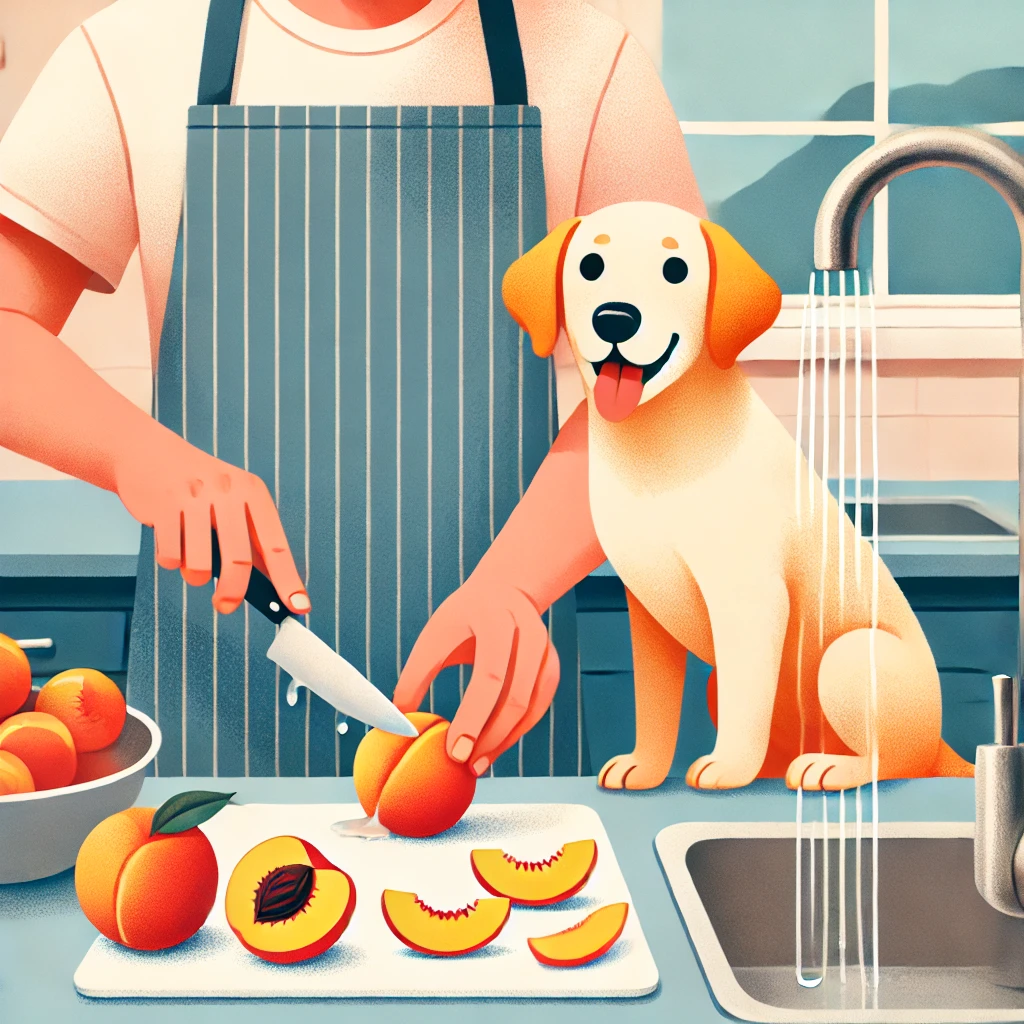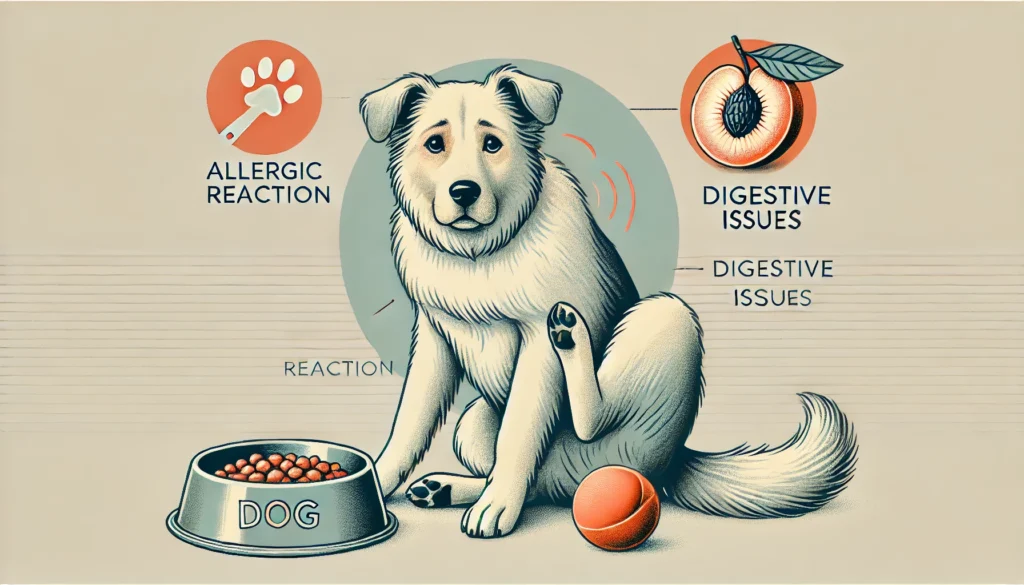
If you’re a dog owner, you’ve likely wondered, “Can dogs have peaches?”
Sharing fruit with our furry friends can be tempting, especially when they give us those puppy-dog eyes.
This post will answer your question by exploring the health benefits, risks, and safe ways to treat your dog to peaches.
Let’s dive in!
Benefits of Peaches for Dogs
Peaches can provide several health benefits for dogs when served correctly:
- Rich in Vitamins and Minerals: Peaches are a good source of vitamins A and C, which support immune health and vision.
- High in Fiber: The fiber content in peaches can aid digestion and promote a healthy gut.
- Antioxidants: Peaches contain antioxidants that help reduce inflammation and protect cells from damage.
Related Product Tip: For dog owners looking to enhance their pup’s diet with healthy fruits, consider some freeze-dried peach treat for dogs.
Risks and Potential Hazards
While peaches offer benefits, there are risks you should be aware of:
- Choking and Cyanide Poisoning: Peach pits are extremely dangerous. They can cause choking or digestive blockages and contain cyanide, which is toxic to dogs.
- Sugar Content: Peaches are naturally high in sugar, which can lead to upset stomachs or weight gain if overconsumed.
- Pesticides and Chemicals: Always wash peaches thoroughly to remove harmful chemicals.
Recommended Product: Wash fruits and vegetables thoroughly with this pet-safe fruit and veggie wash .
How to Safely Prepare and Serve Peaches to Dogs

To safely treat your furry friend to peaches, it’s important to follow a step-by-step preparation process.
This ensures that your dog can enjoy the health benefits of peaches without encountering any of the potential hazards.
1. Select Fresh, Ripe Peaches
- Choose Organic When Possible: Whenever you can, opt for organic peaches to reduce the risk of exposure to pesticides and harmful chemicals.
- Avoid Moldy or Rotten Peaches: Only offer fresh, ripe peaches. Moldy or spoiled fruit can upset your dog’s stomach or lead to other health issues.
2. Wash Thoroughly
- Rinse with Cold Water: Wash the peach thoroughly under cold running water to remove any dirt, pesticides, or contaminants.
- Optional Step: Use a pet-safe fruit and vegetable wash to ensure any residual pesticides are completely eliminated.
3. Remove the Pit (Stone)
- Why It’s Important: Peach pits pose a significant danger due to their hard texture, which can cause choking, and their cyanide content, which is toxic to dogs.
- Method: Cut the peach in half around the pit, twist gently to separate the halves, and remove the pit. Discard the pit immediately where your dog cannot access it.
4. Remove the Skin (Optional)
- Digestibility Consideration: While peach skin is not inherently toxic, it can be tough on some dogs’ digestive systems. If your dog has a sensitive stomach, consider peeling the peach before serving.
5. Cut into Small, Bite-Sized Pieces
- Portion Control for Safety: Slice the peach into small, manageable pieces appropriate for your dog’s size. For smaller dogs, aim for tiny cubes or thin slices; for larger dogs, you can provide slightly larger pieces.
- Serving Tip: Start by offering just one or two pieces to gauge how your dog’s digestive system reacts.
6. Serve in Moderation
- Why Moderation is Key: Peaches contain natural sugars, which can cause digestive upset or weight gain if given in excess. Treat peaches as an occasional snack, not a dietary staple.
- Portion Guidance: As a general rule of thumb, limit the treat to 10% or less of your dog’s daily calorie intake.
7. Monitor Your Dog for Reactions
- Initial Offering Precautions: If this is your dog’s first time eating peaches, watch for any signs of an allergic reaction or digestive upset such as vomiting, diarrhea, or itching.
- Gradual Introduction: Introduce peaches gradually into your dog’s diet and observe their response before offering more in the future.
8. Avoid Canned or Preserved Peaches
- Sugar and Preservatives: Canned peaches are often loaded with added sugar and preservatives, making them unsuitable for dogs. Stick to fresh, unprocessed peaches for a healthier treat.
9. Creative Ways to Serve Peaches
- Frozen Peach Cubes: For a refreshing treat during hot days, consider freezing small peach pieces or blending them into a dog-friendly ice cube mix.
- Mixed with Dog Food: You can mash or dice a few small pieces of peach and mix them into your dog’s regular food for a hint of fruity flavor.
- Peach-Based Dog Treats: Consider making homemade dog treats with small amounts of peach puree as a natural flavor enhancer.
Pro Tips for Serving Peaches Safely
- Avoid Peach Leaves and Stems: These can also contain small amounts of cyanide and should not be given to dogs.
- Moderation Reminder: Always err on the side of caution by serving peaches sparingly, especially if you are uncertain about your dog’s tolerance.
By following these steps, you can safely incorporate peaches into your dog’s treat repertoire, adding a fruity twist to their snack routine while ensuring their health and safety.
If you’re unsure about any aspect of feeding peaches to your dog, always consult your veterinarian for personalized advice.
Portion Control and Alternatives

Why Portion Control Matters
When feeding peaches to your dog, portion control is essential.
While peaches offer nutritional benefits, such as vitamins, minerals, and fiber, overconsumption can lead to negative side effects due to their natural sugar content and acidity.
Here’s how to manage portion sizes and introduce alternatives for a balanced diet:
1. Appropriate Serving Sizes by Dog Size
- Small Dogs: Limit peach intake to one or two small pieces (around the size of a dice). Overfeeding can lead to stomach upset or weight gain quickly in smaller breeds due to their size and calorie needs.
- Medium Dogs: Two to three bite-sized pieces should suffice. This provides a treat without adding excessive calories or sugar to their diet.
- Large Dogs: Four to five pieces can be given on occasion. Remember that even for larger dogs, moderation is key to prevent digestive upset and ensure their calorie intake stays balanced.
2. Frequency of Feeding
- Occasional Treat: Peaches should be treated as an occasional snack rather than a regular part of your dog’s diet. Limit peach treats to once or twice a week, depending on your dog’s overall health and dietary habits.
- Supplement, Not a Staple: Fruits like peaches should not replace your dog’s main diet or regular dog food, which is specifically formulated to meet their nutritional needs.
3. Monitoring Caloric Intake
- Be mindful of your dog’s overall calorie intake. Treats, including fruits like peaches, should make up no more than 10% of your dog’s daily calories.
- Use a calorie tracking method to ensure you’re not unintentionally overfeeding, especially if your dog has weight management or health concerns.
4. Signs of Overfeeding
- Digestive Issues: Overeating peaches may result in vomiting, diarrhea, or stomach discomfort.
- Weight Gain: Regular overconsumption of sugary fruits can contribute to weight gain.
- Hyperactivity: In some dogs, too much sugar can lead to increased energy levels or restlessness.
Healthy Alternatives to Peaches for Dogs
If you’re looking for other healthy, dog-friendly fruits or snacks to add variety to your pet’s diet, here are some great alternatives:
1. Apples (without seeds and core)
- Nutritional Benefits: High in fiber, vitamins A and C.
- Serving Tip: Cut into small, seedless slices for easy digestion.
2. Blueberries
- Nutritional Benefits: Rich in antioxidants, low in calories, and packed with vitamins.
- Serving Tip: Offer a small handful as a low-calorie treat or use as training rewards.
3. Watermelon (seedless)
- Nutritional Benefits: High water content makes it a great hydrating treat, especially in summer.
- Serving Tip: Remove seeds and rind before serving small chunks to your dog.
4. Bananas
- Nutritional Benefits: Good source of potassium, vitamin B6, and fiber.
- Serving Tip: Offer a few slices as an occasional treat, as bananas are high in sugar.
5. Pumpkin (plain and unsweetened)
- Nutritional Benefits: Great for digestion and rich in fiber.
- Serving Tip: Offer a small scoop of canned pumpkin (without added sugars or spices) mixed with regular dog food.
6. Carrots
- Nutritional Benefits: Low-calorie treat, good for teeth and high in beta-carotene.
- Serving Tip: Serve raw as crunchy treats or lightly cooked for easier digestion.
Peach-Based Dog Treats (Homemade Options)
- Peach Frozen Treats: Blend a small amount of peach with plain yogurt and freeze in an ice cube tray for a cool, refreshing treat on hot days.
- Peach Puree Topping: Mash or blend a small amount of peach and use it as a topping on your dog’s regular food for added flavor.
Alternatives for Dogs with Sensitive Stomachs
- Plain Cooked Sweet Potato: A good source of fiber and gentle on digestion.
- Zucchini Slices: Low-calorie, crunchy treat for dogs who need to watch their weight.
- Cucumbers: Hydrating, crunchy snack with minimal calories.
Considerations When Introducing New Foods
- Always introduce new fruits and treats gradually, monitoring your dog’s reaction for any signs of digestive upset or allergies.
- Consult with your veterinarian before adding new items to your dog’s diet, particularly if your dog has specific dietary restrictions or health conditions.
By practicing portion control and exploring healthy alternatives, you can keep your dog’s diet balanced, nutritious, and exciting, without the risks of overfeeding.
Treat your furry friend responsibly and enjoy sharing a variety of safe, delicious snacks!
Signs of Allergic Reaction or Digestive Issues

When introducing peaches or any new food into your dog’s diet, it’s essential to observe their behavior and physical condition for any signs of an allergic reaction or digestive issues.
Dogs, like humans, can react differently to new foods, and some may experience mild to severe reactions.
Here’s what to watch out for:
1. Digestive Issues
- Vomiting: One of the most common signs that a dog is having difficulty digesting a new food is vomiting. If your dog vomits after eating peaches, it’s best to avoid feeding them peaches in the future and monitor their condition closely.
- Diarrhea: Loose or watery stools may occur if your dog has eaten too much peach, reacted to the fruit’s fiber content, or if their digestive system is sensitive to the fruit’s sugars.
- Bloating and Gas: If your dog appears to have a swollen stomach or is passing excessive gas after eating peaches, it could be a sign of digestive discomfort.
- Constipation: While peaches are high in fiber, excessive consumption or lack of water intake could lead to constipation in some dogs.
- Loss of Appetite: If your dog suddenly refuses to eat or shows a lack of interest in food after consuming peaches, it might indicate a digestive issue or discomfort.
2. Allergic Reactions
- Itching and Skin Irritation: Dogs that are allergic to peaches may develop itchy skin, redness, or hives. This may manifest as scratching, licking, or biting at their skin.
- Swelling: Look for swelling around the face, mouth, or throat, as this can be a sign of an allergic reaction and could potentially lead to breathing difficulties.
- Excessive Drooling: While some drooling is normal, excessive drooling after eating a peach could indicate a reaction to the fruit.
- Runny Nose or Watery Eyes: Allergy symptoms can sometimes include nasal discharge or watery eyes, similar to allergic reactions in humans.
- Ear Infections: Allergic reactions to food can sometimes manifest in the form of recurring ear infections, marked by head shaking, ear scratching, and a strong odor from the ears.
3. Breathing Issues
- Coughing, Wheezing, or Difficulty Breathing: If your dog is struggling to breathe, wheezing, or coughing after consuming peaches, seek immediate veterinary attention. Difficulty breathing is a sign of a severe allergic reaction.
4. Lethargy or Behavioral Changes
- Fatigue: If your dog seems unusually tired, sluggish, or uninterested in activities they normally enjoy, it could be a reaction to something they ate.
- Restlessness: On the other hand, some dogs may become restless or agitated due to digestive discomfort.
5. Excessive Thirst or Urination
- Increased Water Intake: Some dogs may drink more water due to digestive upset, dehydration from diarrhea, or sensitivity to the sugar content of peaches.
- Frequent Urination: Watch for any changes in your dog’s bathroom habits following the introduction of peaches.
What to Do if Your Dog Shows Symptoms
- Stop Feeding Peaches Immediately: Remove the food source that you suspect is causing the reaction.
- Monitor Closely: Observe your dog for any changes or escalation in symptoms.
- Provide Plenty of Water: Ensure your dog has access to fresh water, especially if they have diarrhea or are vomiting.
- Contact Your Veterinarian: If symptoms persist, worsen, or are severe (e.g., difficulty breathing, severe vomiting, or swelling), contact your veterinarian immediately for guidance and potential treatment.
- Keep a Food Journal: Note any reactions your dog experiences and the foods they ate, so you can avoid those foods in the future.
By staying vigilant for signs of allergic or digestive reactions, you can keep your dog safe and help ensure that any new treats or foods are a positive addition to their diet.
If you’re ever in doubt, consulting with a veterinarian is the best course of action to determine what’s suitable for your furry friend.
Consulting Your Veterinarian Before Introducing New Foods

While peaches can be a tasty treat for many dogs, every dog is unique.
Before incorporating peaches or any new food into your dog’s diet, it’s wise to consult with your veterinarian, especially if your dog has existing health conditions, allergies, or dietary restrictions.
Here’s why veterinary guidance is crucial:
1. Personalized Nutritional Advice
- Tailored Recommendations: A veterinarian can assess your dog’s health, weight, breed, and overall nutritional needs to provide tailored advice about whether peaches or other fruits are suitable.
- Safe Alternatives: If peaches are not ideal for your dog, a vet can suggest alternative fruits or healthy treats that provide similar nutritional benefits without the risks.
2. Addressing Specific Health Concerns
- Diabetes and Obesity: Dogs with diabetes or weight management issues may need to avoid high-sugar foods like peaches. Your vet can offer guidance on low-sugar alternatives or safe portion sizes.
- Kidney or Liver Conditions: Certain fruits, including peaches, may need to be restricted or eliminated from your dog’s diet based on specific organ health conditions.
3. Allergy Testing and Monitoring
- Identifying Allergies: If your dog has a history of food allergies, a vet may recommend a gradual introduction of new foods and monitoring for signs of allergic reactions. In some cases, allergy testing can pinpoint specific triggers.
- Digestive Sensitivities: Dogs with sensitive digestive systems may need extra precautions or modifications before trying new foods. A vet can guide you on how to introduce new treats with minimal risk.
4. Safe Feeding Practices
- Proper Preparation Techniques: Veterinarians can offer detailed advice on how to prepare and serve fruits safely to your dog, minimizing choking hazards or other risks.
- Recommended Portion Sizes: Based on your dog’s size, age, and health status, a vet can provide precise guidelines for safe portion sizes to prevent overfeeding.
5. Monitoring Health Changes
- Tracking Reactions: If you’ve introduced peaches to your dog, your veterinarian can help you monitor for any adverse reactions or recommend changes to their diet if necessary.
- Regular Check-Ups: Incorporating new foods is a great reason to discuss your dog’s overall health and dietary needs during routine vet visits.
Final Tip: If you’re unsure about feeding your dog peaches or any new food, always err on the side of caution by seeking professional advice.
By working with your vet, you can safely expand your dog’s diet while prioritizing their health and happiness.
This proactive approach helps ensure that your dog enjoys all the benefits of a diverse diet without unnecessary risks.
Expert Opinions and FAQs
Can Puppies Eat Peaches?
It’s best to avoid giving peaches to puppies, as their digestive systems are more sensitive.
Are Canned Peaches Safe for Dogs?
No, canned peaches often contain added sugar and preservatives that can be harmful to dogs.
Conclusion
So, can dogs have peaches?
Yes, but with proper preparation and moderation.
Enjoy treating your furry friend while ensuring their health and safety by following these guidelines.
Have you tried giving your dog peaches?
Share your experience in the comments!
Explore More: If you enjoyed this post, check out our other guides below:
Can Dogs Eat Nectarines? Benefits, Risks, and Everything in Between
Can Dogs Eat Pineapple? Everything You Need to Know Before Sharing
As an Amazon Associate, I earn from qualifying purchases


